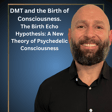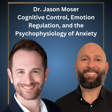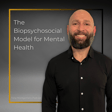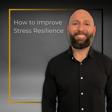Become a Creator today!Start creating today - Share your story with the world!
Start for free
00:00:00
00:00:01

Exercise as a Way to Improve Mental Health
In this episode I discuss how we can use exercise to improve our mental health. I discuss the mechanisms of action to get a better understanding of how exercise can help improve mental health. Developing a biopsychosocial model to create a better understanding of mental health. Psychological strategies to improve motivation and adherence. Along with exercise prescription ideas that are backed by research to improve mental health.
Transcript
How does exercise improve mental health?
00:00:00
Tony Montgomery
Today we're gonna talk about the role that exercise plays in improving mental health. um We're gonna discuss some of the mechanisms at play and and how that can ah factor into some of the decision making depending on what mental disorder you're gonna be working with. We'll also talk about the differences between aerobic exercise and resistance training and exercise and how one or the other may be more beneficial for um certain ah mental health disorders and will continue to explore the idea that ah exercise is great as a therapeutic tool, but we also will have to incorporate some of the psychological components to improve motivation and self-advocacy and self-mastery.
00:00:44
Tony Montgomery
that exercise can bring about that people suffering with mental health disorders tend to have a hard time um bringing to the forefront. and So we'll we'll discuss those parameters and hopefully give you an idea of some tangible things that you can take away to improve mental health through exercise.
What is the global impact of mental health disorders?
00:01:03
Tony Montgomery
One of the things that's good to touch on in these situations is kind of the role that mental health disorders plays and in society and and why it's important to um overcome them and then have structures in place that allow us to ah help people get better. ah We have talk therapy, we have pharmacology, and both of those are are great ways to do it. um But exploring in that mind-body concept, that biopsychosocial concept of um how to get people healthier is going to be the forefront of, I think,
00:01:37
Tony Montgomery
ah the revolution of mental health and and improving mental health ah beyond talk therapy or in conjunction with talk therapy and pharmacokinetics as well. So mental health disorders have become worldwide burden.
How effective is exercise compared to traditional treatments?
00:01:54
Tony Montgomery
they They look at it as disability adjusted life years. They call them dailies. And dailies are the combination of years of life loss due to premature mortality ah with years of life loss due to a disability. With depressive disorders being top of the list, anxiety being second on that list.
00:02:14
Tony Montgomery
and understanding that within those mental health disorders, they get further compounded with comorbid somatic disorders ah that lead to a life expectancy of 15 to 20 years shorter compared to the general population. Exercise has been shown to be an effective intervention.
00:02:33
Tony Montgomery
with moderate to large effect sizes when you look at the meta-analysis that are floating around. um Some seem to be better than others, and we'll we'll get into that. um But it has been shown to be just as effective as talk therapy and pharmacology. And when you compare it to pharmacology, it's going to be beneficial um in terms of not having the the negative side effects that could come along with pharmacology. And it's going to help with other diseases that encompass age, sedentary behaviors, which happens a lot with mental health disorders, things like improves cardiovascular disease, metabolic syndrome, high blood pressure, your type two diabetes, um stroke, cancer, like exercise has been shown to to improve all those things. And it'd be easy to dismiss ah pharmacology and and talk therapies and say, why aren't more people prescribing exercise and
00:03:31
Tony Montgomery
based on Based on the literature, the the biggest barrier for therapists is, and and it makes sense coming from an exercise science background, that they just do not feel competent prescribing exercise to their clients. um Now, whether you believe that or not, I think i think it's irrelevant. I think um the understanding that going through eight years of school in exercise science, seeing master's students, seeing PhD students, they have a hard time prescribing actual good exercise science pro or science exercise um training protocols. So I think
00:04:17
Tony Montgomery
Just based off of that, based off seeing it myself, I can understand why therapists have a hard time prescribing something that they have limited knowledge on.
Integrating exercise with therapy: Challenges and solutions
00:04:27
Tony Montgomery
You're going to school for eight years to focus on psychology or pharmacology. you're and very rarely going to get sprinkled in with a nutrition class or an exercise class. And that's just not enough. And we can't expect them to to learn that in conjunction with what they're already learning. It would be like asking exercise scientists to um know the ins and outs of psychology as they graduate and be able to prescribe psychological interventions to their pay to the to the people that they work with.
00:05:00
Tony Montgomery
I think understanding psychology is great for personal trainers and exercise science majors, but I also understand that it's just not something that can actually take place. So the thing we want to focus on is like, hey, how can we get the information out there? How can we create some type of structure to where therapists feel comfortable prescribing exercise as as an intervention?
00:05:25
Tony Montgomery
And I think one of those ways is to um talk about the the mechanisms, talk about the benefits, talk about how they can make it in conjunction, put them together, ah exercise and therapy, exercise and pharmacokinetics, because the research does show when you combine those interventions together, it outdoes the interventions by themselves. So don't think of it as exercise as the end all be all, and we'll discuss why it can't be the end all be all.
00:05:53
Tony Montgomery
but think about it in terms of an adjunct to what's already going on, what they already feel comfortable with. And I think one of the ways we can look at it is mental health disorders for a very long time have been thought of as just this chemical makeup of the brain that's dysregulated through serotonin, through dopamine dysregulation. And then that's why they come up with all these pharmaceuticals. And I think they they think of it as like a brain in a vat and there's this disturbance and
00:06:27
Tony Montgomery
I think that does a couple of things because the the research shows that there's there's a lot more going on than serotonin and dopamine and and all these other things. there's There's a social component, there's a biological component, and there's a psychological component. And that's what makes up this idea of a biopsychosocial model to approach evaluating mental health And I think that that is the the fundamental way to go because you're taking in all the different components and exercise can be um all three of those components at the same time.
What are the challenges in exercise research for mental health?
00:07:00
Tony Montgomery
So I think that's the way we want we want to look at it. And we want to understand um some of the
00:07:08
Tony Montgomery
Some of the obstacles that create an exercise assisted therapy has to overcome. um One of the biggest one is lack of rigorous study design and that builds off of each prior work with single manipulation so we can get a better understanding of what exactly is going on, have better definitions of What is frequency intensity session duration and length of intervention. I think ah a collaboration of psychology and exercise can go a long way and um create and clear and concise definitions of these things and being able to put them into practice, ah the idea of um
00:07:48
Tony Montgomery
acute versus chronic exercise, looking at things like cardiovascular resistance training. How can we equate for volume? How can we match these things up appropriately? And that's by understanding the different intensity domains that they're going to be training at and and how to best get those. um Another thing to be conscious of is just getting larger sample sizes. When you're running interventions, it's it's a very difficult thing to do to get large sample sizes.
00:08:14
Tony Montgomery
and how much information can we provide to create um reliability and and replication over the long run so that we can build on these things. I think that's going to be one of the the key approaches to overcome and getting exercise assisted therapy into the practice. And I think that starts with with the researchers and and what they're looking at.
00:08:39
Tony Montgomery
um I also think that we should integrate motivational and behavioral strategies in exercise as well because we are well aware that exercise is beneficial, extremely beneficial for improving mental health. um but trying to get somebody who has mental health disorder to to start exercise and um can be an astronomical ask. So we have to think about ways to improve
Can exercise help with cognitive decline?
00:09:05
Tony Montgomery
um their motivation, their adherence to exercise. We don't want to increase the risk of of dropouts, even though the research shows that ah dropouts of exercise interventions is is very similar to dropouts of top therapy. um So there's not much of a
00:09:21
Tony Montgomery
um distance between those two. um But we also have to factor in the um healthy healthy user bias as well. People that sign up for exercise interventions are going to be people that find exercise to be enjoyable for the most part. So it's how can we get those sedentary people? How can we get those people that um do not like exercise to be motivated and to drive behavior to to get there. So I think all these things are what we should be focusing on as researchers ah to build a better idea.
00:09:53
Tony Montgomery
now To get into some of the the mechanisms at play here when we're talking about mental health disorders, we know that the research shows that mental health um is correlated with cognitive function declines. That declines with age is very similar to the declines we see with mental health disorders. So we see attention not being great, short and long-term memory.
00:10:18
Tony Montgomery
um mainly focus in on negative memories. is It's very hard for them to focus and and retrieve positive memories due to um the way that depression and anxiety and and those type of things start to manifest um in the body. And yeah We see those same declines in PTSD, bipolar disorder, um that are very similar to the neurodegenerative diseases of Alzheimer's and um Parkinson's disease. and We have to ask ourselves, like why why is that the case? What's going on? and We do know that
00:10:55
Tony Montgomery
um There's a lot of crosstalk between the prefrontal cortex, the hippocampus, and the amygdala, and those white matter tracks that connect those areas. um What we've seen in the research is that they start to diminish um through long-term depression, right? So you start to see the pruning and the depression, and that takes away some of the synaptic plasticity, that takes away the strength of those synapses to to fire together and and wire together.
00:11:24
Tony Montgomery
um And what we've seen ah with the implementation of exercise interventions is that it's enhanced neurogenesis in those areas and created thicker fiber tracks between the um hippocampus and the amygdala in the prefrontal cortex. And like I discussed in the first episode of the podcast, that those interactions help with um executive function, help with reducing negative stimuli, the fear response to negative stimuli.
00:11:54
Tony Montgomery
helps with improve attention to positive stimuli, and it can help reduce reactivity ah when there's aversive stimuli or fear. and It can blunt the fear response and improve one's ability to make appropriate decisions in the face of ah of a stressful stimulus. right But we're able to get those connections much stronger. and Not only white matter, we see connections growing, but we also see gray matter areas as well.
00:12:23
Tony Montgomery
A study done by Botoli and Saba in 2017 found that a large network of brain areas equal to about 82% of total gray matter can be altered due to the implementation of exercise into daily life.
00:12:39
Tony Montgomery
And that alteration in growth can be linked to increased cerebral blood flow and volume, which promotes the development of of new neurons. Another contributor is through neuronal changes and growth of new neurons due to the release of neurotrophic factors, things like um BDNF and nerve growth factor, um which has been shown to be released um and and bo is it in a dose response to to exercise. So the the longer the duration, the more intense the exercise, the higher the release of these new trophins that we that we see. And all this helps form and shape new synaptic plasticity and cell genesis um and
00:13:18
Tony Montgomery
people that suffer with with mental health disorders have low baselines of of these things. So if there's ways to acutely and chronically increase those through um exercise, that's going to improve their baseline and allow them to um create different synaptic plasticity, different neurogenesis, different ways of seeing the world, right? And so it's going to allow them to do all those things And I think that's one of the that's one of the big benefits is um how can we improve those neurotrophins? How can we improve blood flow to the brain area? And another one we want to focus on is the upregulation of of the proteins that happen
00:13:59
Tony Montgomery
um through exercise, both resistance training and through aerobic exercise, things like insulin growth factor one, um vascular endothelial growth factor, which improves neurogenesis and long-term potentiation, which is needed for memory consolidation, as well as new blood vessels
How does exercise enhance brain health?
00:14:17
Tony Montgomery
are forming. So we get those new blood vessels. When we get better blood flow, we get better circulation, which is going to help release more of those neutrophins.
00:14:25
Tony Montgomery
um And exercise has been shown to stimulate that peripheral increases from the liver, muscles, and blood cells. And those are known to cross the blood-brain barrier. So we have to think about, yes, exercise does release all these things in the body, in the muscles, um also in the brain. But ah the things that get released in the muscles and in the body, are they able to go through the blood-brain barrier? what What role, what mechanism do they have in that? And the when we When we release the neurotrophins and the proteins, ah they're they're crucial components for formation of new neurons, LTP, enhanced synaptic plasticity and improvements in memory and and attention ah with most of the release happening, but but not limited to the hippocampus area.
00:15:14
Tony Montgomery
and Exercise has been shown to also have a big expression of clotho, which is a pleiotropic protein that regulates age ageep-independent and independent pathways. And that's going to help with the aging process. we We talk about lifespan and health span and exercise. And clotho has been very much linked to um creating better health spans and life spans in conjunction with each other.
00:15:43
Tony Montgomery
And by doing that and releasing those things, um we get this increase in stem cell numbers, increase in a regenerative response, low apoptosis incidence in pancreatic B cells. So we're going to see improvements in um renal fibrosis and cancer metastasis and just lower risk of of cardiovascular disease all around.
00:16:06
Tony Montgomery
Now getting back to this idea that um things get released within the muscle and and what role does that play in helping things cross the blood-brain barrier. And what we've seen is that skeletal muscle is a secretory organ um and it releases a host of cytokines and other peptides that are classified as myokines within the research.
00:16:30
Tony Montgomery
And these structures mediate muscle organ crosstalk ah to the liver, gut, pancreas, adipose tissue, brain, vascular bed, um skin. And what we've noticed is the key mechanisms, to they're one of the key mechanisms to enhance in BDNF. And some of those mechanisms you guys may have heard of, may may not have, but one of them is the cathepsin B, um and it's a lysosomal cysteine protease which functions in intracellular protein catabolism. It's upregulated in both the brain and skeletal muscle following exercise, and it can cross the blood-brain barrier which leads to increased expression of BDNF mRNA and increased BDNF protein levels as well as increase in levels
00:17:26
Tony Montgomery
of double-cordin, which has neuroprotective effects. And then another one, all in conjunction with exercise, is irisin. And that's encoded in, it has its effects in brown tissue. So it creates brown in effects and white adipose tissue. And that increases energy expenditure and improves glucose tolerance, which can help reduce type 2 diabetes. But When looking at it, and endurance exercise does this, it stimulates increases um in the hippocampus of the this irisin, which is encoded in the FNDC5 gene.
00:18:12
Tony Montgomery
um I know these these acronyms and everything can get convoluted, but the the idea is that it's activating this gene expression, which is activating this transcriptional coactivator of mitochondria biogenesis. So think of it in terms of we're improving in mitochondria biogenesis and oxidative metabolism in in muscle and and brown adipose tissue, and this helps um improve those gene expressions in in the hippocampus, along with within the body. And they found that
00:18:47
Tony Montgomery
um boosting the brain levels of the FNDC5 rescue synaptic plasticity and memory in mouse models of Alzheimer's disease. and How does that correlate over to human interactions and interventions? um we don't We're not as familiar with, but um we do know that we are seeing these gene expressions in mice and it's been shown to um potentially have the same carryover and into humans. Endurance exercise has also been shown to increase um beta-hydroxybutyrate, which is a ketone. It's one of the the main ketones that um have the positive effect of a ketogenic diet, and that crosses the blood-brain barrier through MCT transports.
00:19:37
Tony Montgomery
and that accumulates in the hippocampus. So a lot of this stuff is accumulating in the hippocampus, um which is one of the areas of ah memory that projects onto other areas of to create memory. um Because what we know is that if the hippocampus gets damaged, the ability to um form new memories gets disrupted, but the old memories stay intact. So it doesn't necessarily destroy old memories, it destroys the ability to um create new memories. So that tells us that memories are stored in different parts of the of the brain and being able to um
00:20:18
Tony Montgomery
get these releases of these um proteins, of these proteases, of of these BDNFs into those areas is going to help with better signaling to those areas um to create memories that are more positive in in nature because that allows you to do that through through exercise, through um even through um some forms of of talk therapy. and So the um beta hydroxybutyrate is neuroprotective and it's been shown to protect striatal and dopaminergic neurons, ah which is going to be very important for the neurotransmitters to be released within the within the brain.
What role does exercise play in neurotransmitter balance?
00:20:59
Tony Montgomery
and Another role that these um transporters have is they they transport lactate and lactate is a derivative of exercise. Once you get to that lactate, the rest of your body starts producing lactate, um which is an energy substrate that the body uses to continue to to make energy when ATP becomes deficient. um But with lactate, we also get things like hydrogen and inorganic phosphate, which are fatigue mechanisms. But what what they found with the interesting thing with with lactate is that it's a
00:21:36
Tony Montgomery
um
00:21:39
Tony Montgomery
It produces ah glucose oxidation when oxygen uptake is low and can buffer acidosis, but it also transports from astrocytes to neurons and plays a crucial role for memory formation and increased expression of BDNF. And what they found through the research is that by injecting people with um Lactate without the exercise we have seen increases elevations of ah BDNF um and those help with the potentiation into um the NMDA glutamate receptor. So it's all going into this formation of of memories and
00:22:23
Tony Montgomery
um and improvements of of memory and those connectivities, those white matter tracks continue to get stronger and stronger. and other mechanisms at play that improve through exercise that are associated with mental health disorder. We have things like mitochondrial function, which we touched on a little bit, um biogenesis, and the creation of new neurons, neurotransmitters, and the um HPA access. So just to to touch on those things just to just a little bit.
00:22:59
Tony Montgomery
um with mitochondrial dysfunction that leads to impairments in energy production, which have been linked to to mood disorders along with higher levels of um oxygen-native species. And what aerobic exercise has been shown to do is it's been shown to ameliorate the loss of skeletal muscle mitochondria content and significantly decrease reactive oxygen species. So very positive thing in terms of boost in the mitochondria, which is the um powerhouse of of the body that produces energy. And another thing which we touched on a little bit earlier was this idea that we have this these chemical responses in our brain, these neurotransmitters, and there's a lot of imbalances in them. And um for the longest time, we strictly focused on that type of research and focused on serotonin
00:23:51
Tony Montgomery
being one of the biggest drivers of that. And we also focus on dopamine and noradrenaline and and glutamate now, ah with the research showing that like when you're able to um improve glutamate receptors through ketamine, we're able to see a mood increase and has nothing to do with serotonin in people with depression. So it goes to show that there's ah the neurotransmitters do play a particular role, um but it's hard to pinpoint just one that plays that role. And that's one of the issues with the pharmacology is that it it's putting in these and adjusting them. And there are definitely good efficacy behind them. um But it is just kind of a guessing game. And we have to try to get out of that role ah of guessing, even though we want to move people forward and help them with their mental health disorders. I think it's
00:24:49
Tony Montgomery
more important to focus on um particular mechanisms that can that can drive this and that is something that hopefully starts to get looked at a little bit more. I know they're starting to look at that through um optogenetics and the lens of optogenetics and ay and being able to specifically point out different receptors. So I think that'll be the way that we move forward. um But one one of the things with the neurotransmitters having low availability, um the SSRIs, it prevents serotonin and noradrenaline from being reabsorbed. So it's blocking the reuptake and it's block it's inhibiting the reuptake so that leaves more freely floating around um neurotransmitters. and
00:25:35
Tony Montgomery
they think um over time that helps improve the brain chemistry. um It doesn't happen right away, even though it's reacting right away in the brain, but it does take six to eight weeks. um And some people will even see a deficit, a dip in their mental health the first week or two. um Anytime you're messing with brain chemistry, it's going to be a big teeter-totter, back and forth of good and bad, good and adjust, adjust, adjust, trying to figure out what the right prescription is, what the right dose is. um So it's something to to pay attention to, and it's something that exercise has been shown to help with neurotransmitters being released in the brain. But from what I've seen in the literature lately,
00:26:24
Tony Montgomery
It's not nearly as important as it used to be. um And we need to move away from that model or at least challenge that model more and and come up with a better understanding of it.
00:26:36
Tony Montgomery
um But another thing that we that I touched on is this HPA dysregulation that happens when um stress is high and people that suffer from mental health disorders have ah significantly high levels of of cortisol being released chronically. And that's going to cause a depression of or dysfunction in the HPA.
How does exercise influence motivation and emotional regulation?
00:26:59
Tony Montgomery
And that's been shown to um heighten a or or reduce cortisol production, um come compromise sensitivity to glucocorticoids, and a hyper secretion of corticotropin um release hormones. And moderate to intense aerobic exercise has the ability to attenuate that HPA response to stress, thus improving mood disorders.
00:27:25
Tony Montgomery
um
00:27:28
Tony Montgomery
Marked by hyperactivity of the HPA access but one thing we do want to consider is that if we are um working with people who have that HPA dysregulation focus in on how much volume we're driving into them um by by driving more volume could create more dysregulation. So we have to really pay attention when we are dealing with that type of stuff. And and that could be looked at through um simple cortisol, blood work, things like that to see where this dysregulation is going after some of the hormones that it could be um compromising.
00:28:05
Tony Montgomery
and um Another one you're going to hear about too is is inflammation within the body. IL-6 is a very baseline. IL-6 is a very keen marker for mental health disorders. People that have mental health disorders have higher levels of IL-6. But what we see within the research is that um When we exercise, we release IL-6 into the bloodstream and the the release of IL-6 from the muscles actually has a protective effect. It's it's more anti-inflammatory than pro-inflammatory.
00:28:42
Tony Montgomery
So IL-6 has been one of those markers that we've looked at for some time and are starting to move away from as a predictor. And we're starting to look at things like tumor necrosis factor alpha and interleukin beta, um interleukin 1 beta as better predictors and things that we should focus on reducing, which the release of IL-6 does reduce um the tumor necrosis factor.
00:29:08
Tony Montgomery
ah so It's a good thing because we have these releases of things. So so there's pro-inflammatory and anti-inflammatory and IL-6 kind of plays both those depending on how it's released. When it's released from cortisol, the HP access um modulation of stress, reactivity, and anxiety and any dysregulation of that is going to cause widespread IL-6. So that's the that's the baseline one that they're looking at to associate with um
00:29:41
Tony Montgomery
with mental health disorders. Whereas if you're doing an exercise protocol and say you take blood samples afterwards, you're gonna see high levels of IL-6. So that would not necessarily be something that would correlate to um what you could potentially be looking at. So an exercise, it helps reduce the secretion of the pro-inflammatory markers. And um I think focusing on that,
00:30:08
Tony Montgomery
and the creation of um the release of the anti-inflammatory ones. um I think that's one of the biggest focuses and the biggest things that exercise can do for improving that.
00:30:22
Tony Montgomery
and Another thing that exercise does is it's it helps regulate the autonomic nervous system. It helps improve your HRV. And meta-analysis have shown that ah low baselines of of HRV is is very much correlated to um higher bouts of depression and anxiety. So by by exercising, we can see those improvements in in HRV in their autonomic nervous system.
00:30:49
Tony Montgomery
and um we can see reductions in in stress um by by implementing those things and and their ability to to cope with stress, um which HRV is a predictor of, is how stress-resilient you are is gonna be predictive in the HRV a lot of times um due to its role in accessing the autonomic nervous system. And we know we can improve HRV through breath work,
00:31:17
Tony Montgomery
um recent research in the lab ah that I work in, we've seen that through cognitive reappraisal and um exercise combined, we've seen um improvements in HRV. So I think that's one of the things that we can focus on to improve and allow them to to regulate, give them the skills to regulate that stress response as much as possible.
00:31:47
Tony Montgomery
So those those are kind of, um in short, ah some of the mechanisms that aerobic exercise can do and resistance training exercise can do to improve the bio part of the biopsychosocial model. ah So we have improvements in neurotrophins, we have improvements in ah proteins and and hormones, we have improvements in neurotransmitters, we have improvements in inflammation, HPA access regulation, mitochondria, um improvements in cloth expression. so So those are the things that
00:32:23
Tony Montgomery
mechanistically is what's going on. um But again, understanding the mechanisms is just a a small portion. Getting them to exercise and and be excited to exercise, that's that's the biggest thing. But I think it's really important to understand the mechanisms of of action. right because um And that's why it's been shown when you when you add resistance training and cardio, you're going to get better benefits because you're getting a ah lot of the muscle secretions or the myokines that are being released from the muscle. And that allows for better access and crossing of the blood brain barrier. So in conjunction with each other, and the research has shown that that's been um able to improve better than the interventions by themselves. um But
00:33:08
Tony Montgomery
We want to focus on um also the like the the psychological component as well, and thinking about how we can improve um psychological well-being. And I think one of the things that we have to overcome is ah people that suffer with mental health disorders are faced with negative emotions um that can be extreme or or very long-lasting.
00:33:30
Tony Montgomery
and that can interfere with the person's ability to to function. um Those emotions, the anhedonia, the inability to feel pleasure, reduced motivation, hopelessness, low mood, loss of interest. So you can see these are these are the mechanisms at play psychologically that's gonna make it very difficult for us to um get people to wanna start exercise and adhere to exercise. And we have to figure out ways to make exercise more enjoyable so that they can overcome some of those things.
00:34:02
Tony Montgomery
So one thing that we want to look at is how can we incorporate the emotion regulation strategies and how does aerobic exercise specifically play a role? So this is looking at more aerobic exercise and its role in improving emotion regulation. And what the research shows is that um throughout each process, aerobic exercise plays a significant role in the emotion regulation. So we have the perception, the valuation, and the action.
00:34:30
Tony Montgomery
and through aerobic exercise and improving in those brain connections, it allows for better reactions to to all those. It diminishes the perception by diminishing the aversive stimuli, the negative stimuli. It allows you to pay more attention to the positive. So then your perception of the stimulus in front of you is now lower and less aversive than it used to be.
00:34:55
Tony Montgomery
And then it also plays on the valuation phase as well. So if we're able to... um reevaluate the stress through cognitive reappraisal and being able to improve those areas, that's going to help with that amygdala um and function and functional connectivity um with the oral frontal cortex and and the insula. So that's going to help create more positive moods and it's going to create more attention to um
00:35:27
Tony Montgomery
preference positive valence and and positive stimuli and decrease um perception and reactivity to native valence stimuli. So it's it's shifting what they're paying attention to and and how they see things. And I think that's one of the powerful things of of aerobic exercise and how that can improve the psychological component.
00:35:47
Tony Montgomery
um another um technique that you can use during this phase that's been shown to um create positive benefits is is exercise um allows for a form of of distraction. A lot of people that suffer mental health disorders, they um have these intrusive thoughts and they begin to ruminate and ruminate and ruminate and they just can't get out of them. um Distraction is ah is a key way to overcome that rumination and then
00:36:17
Tony Montgomery
And then from there, as you're distracting yourself through exercise of that, and then you get all those other benefits that allows you to reappraise the situation, you're going to be able to work through things in your mind. And we know that after exercise, mood increases. So those things that are ruminating, those things that you those intrusive thoughts are going to be shifted more towards a positive valence. So that's one of the things that that exercise um can do. And it's,
00:36:45
Tony Montgomery
focus in on there's two distraction methods and they both broadly relate to associative. So paying close attention to one's body and performance or disassociative mentally distance oneself from sensory input. So those are kind of the two distraction things that we can use to facilitate. So we can implement that within aerobic exercise to allow for um a more enjoyable experience. So by having our
00:37:17
Tony Montgomery
um the people that we're working with, um whether it be sedentary people or people with mental health disorders, I think a lot of this can be applicable to to both um by telling them, we want to pay close attention to what your body's doing, how your body's feeling. You're taking them out of their mind and and into their body. And that's one of the things that mindfulness and and meditation has been shown to do as well. And then you can also teach them you know that we're, hey we're gonna be outside and I want you to focus on the trees, the clouds, the you know the people that we run by, the the animals, right? That's gonna allow for distraction as well. that Anything that we can do to get them out of their head um is gonna be a positive thing and it's gonna increase the positive experience of of exercise. It essentially just gives them a mental timeout, gives them time to to relax and get those intrusive thoughts out of their head. And and what that also does is it gives them a tool
00:38:11
Tony Montgomery
So when they have intrusive thoughts, when they have rumination, they can say, oh, you know what, I'm going to go for a run today because running helps me get rid of that. So that's going to boost motivation and self-efficacy in terms of them wanting to exercise. And then they found that um Active distraction had a greater capacity to alleviate depressed mood than passive distraction or active ruminating or passive ruminating. So passive or active distraction is is the is the way to go get them out of their mind and focus in on that. And then during the evaluation phase, individuals will either process the stimuli as positive or negative. So teaching them the tools of cognitive reappraisal,
00:38:56
Tony Montgomery
um And along with exercise has been shown to improve the reframing process of the stimulus um by eliciting better um efficiency of cognitive reappraisals, which allows the individual to see negative adverse stimuli and create it into a ah positive thing, um which can help change their emotional trajectories. So we're focusing on any time a negative thing comes up like boredom or ah pain or um being out of breath
00:39:26
Tony Montgomery
right? Reappraising that to a positive thing of um the challenge of overcoming boredom. How can I push myself? And um what's good about challenging myself? And also the more I can push through my lungs burning and my legs burning, um the the better my mental health is going to be, the better my physical body is going to be. So we're constantly working on reframing it and giving them those tools is going to be very helpful um in that process.
00:39:53
Tony Montgomery
And then exercise plays a role during the action phase by enhancing brain oxygenation and and blood glucose delivery, which in turn boosts neurotransmitter efficiency and can improve inhibitory control efficiently in the prefrontal cortex. So this is all happening um within the prefrontal cortex. And it allows individuals to critically work through the emotional stimulus and inhibit any negative actions towards that stimulus.
00:40:19
Tony Montgomery
um There's been a handful of of theories explaining improvement in emotion regulation and they they talk about um the arousal hypothesis, the the dual mode theory, um which talks about the U-shaped curve of exercise. When you have very low intensity, you don't really get much out of it. When you're in that moderate intensity phase, um you're going to perceive it as more enjoyable and you're going to get more out of it and get those mood boosts in um effects And then if you get into the too intense phase, um potentially that can cause negative effects. Although there was a beautiful meta analysis that was put out looking at exercise hit as a form of improvement of of mental health. and And what they found was that, yes, right after exercise, the high intensity interval training had either a um
00:41:14
Tony Montgomery
the exact same response as moderate intensity continuous training or a slightly higher negative response. But when they continued after 15, 30 minutes, 60 minutes, they did continuous checkups, they found that the high intensity group had actually higher and better improved mood rates and self-efficacy compared to those moderate. so It depends on when they're actually asking these questions will determine what the um negative effects can be. So we that's, that's one of the things we we really want to um think about and touch on and
00:41:53
Tony Montgomery
um One of the things too that that aerobic exercise can do and and resistance training, it can can create better self-efficacy and finding ways to improve self-efficacy um by teaching them um the benefits of challenging tasks and persisting longer in the face of adversity. right These are all um part of that talk therapy that we can start to incorporate to get them And the exercise has been linked, it creates feelings of of mastery and it boosts self-esteem. And it's been linked to self-perception and self-evaluation. Individuals who engage in regular exercise consistently demonstrate higher levels of self-efficacy. And and then that makes sense, right? Like we we know that, um
00:42:43
Tony Montgomery
making improvements, making in progress, making steady um and strives towards your goals is going to improve how you feel about yourself. So being able to set those goals and and doing that with your client and allowing them to get these small wins all the time is not only going to boost motivation, but it's also going to show them that, hey, like I can master this, I can be more self ethical, I can do these things and and and accomplish them, right? Whereas previously I didn't think I could. I didn't think I could even get out of bed. So we're beginning to build this.
00:43:19
Tony Montgomery
idea of you know the benefits of exercise, but then also like how we can get them to do that. Goals set in, um teaching them about what happens. ah Research has shown that by a instructing them on the benefits of exercise and um allowing them to know that by improving these synaptic plasticities, like it can allow them to change their belief of of who they are and how they see themselves and in the world.
00:43:47
Tony Montgomery
So I think it's important to um create these goals and create these individualized workout plans as opposed to these basic, you know, everyone should follow this template because we know everyone has different experiences and perceptions of their mental health disorders and their sedentary behaviors and how we can understand those things and incorporate um different exercises is going to be um extremely important.
00:44:15
Tony Montgomery
So one of the things to to to think about is that the the mood disorders themselves, they cause impairments and difficulties to the um psychosocial interaction, but they found that inpatients at a psychiatric hospital expected to increase their social interaction through sports and exercise. So just the the idea of being able to get outside and and interact with people is starting to boost that social component, that social dynamic that a lot of people with mental health disorders tend to, um tend to see collapse.
Social benefits of exercise for mental health
00:44:49
Tony Montgomery
And the the research on that, that um
00:44:53
Tony Montgomery
brand at all did in 2018, they found that one bout of exercise in patients with mental health disorders reported improvements in mood, physical strength, attention, and appreciation for social interaction, along with a decrease in rumination and tiredness. That's one bout of exercise. So it doesn't take much to start seeing and incorporating these improvements, but we have we have to get them in there. We have to get them striving for that.
00:45:21
Tony Montgomery
And exercise is also one of those things where um it allows for the affect cognition, cognitive process um that maintains the psychological symptoms. um So like rumination is defined as like these constant repetitive thoughts and these intrusive thoughts. And um it creates these feelings of entrapment and hopelessness.
00:45:49
Tony Montgomery
which can form into suicidal ideation. And we see that with mental and physical training, it's been shown to be effective increase in increasing that cognitive control process and decreases ruminative thought patterns. um By combining meditation for 30 minutes and moderate intensity aerobic exercise for 30 minutes, um that's what they found in the the research. The research was done by Alderman et al.
00:46:14
Tony Montgomery
in 2016. And it's been shown that just 30 minutes here, 30 minutes there um can make those improvements. So I think that's one of the things that we have to overcome as um practitioners is this idea that, you know, oh, the exercise battle has to be an hour that that can be so overwhelming for people who have never exercised or who don't want to exercise. What we're seeing is that these quick, acute bouts, 20, 30 minutes of exercise, we get them in, get them out, they're excited about it. That can have extremely positive benefits. So we want to make sure that the
00:46:49
Tony Montgomery
the goals we set for the the clients aren't so grandiose that they just feel like there's no way. like There's no way I'm going to be able to um even touch that. So why even start? right So we want to be able to get that out of there out of their head and get rid of, like like yeah like I said, we're trying to get them out of their head and and into the the the world, into their their body. um And we've seen that with like acute chronic exercises,
00:47:19
Tony Montgomery
the Obviously, with we start to see a lot of the benefits right around like the week six, week eight, um but we're also getting those really brief positive expressions of mood and um motivation. So we have to capitalize on those. We have to make sure that we're able to um continue to build on that, and that's by creating a fun, interactive environment, setting goals,
00:47:45
Tony Montgomery
um trying to improve that psychodynamic by maybe doing group classes.
What are optimal exercise guidelines for mental health?
00:47:50
Tony Montgomery
Like there's a bunch of things that we can start to incorporate ah motivational interviewing, um reappraisal strategies, emotion regulation strategies, and and again, just teaching them the benefits of that type of stuff. So one of the things that that we want to focus on is kind of like,
00:48:13
Tony Montgomery
where do like Where do we begin? And again, acute bouts, as little as 20 to 40 minutes of aerobic exercise at moderate intensity have been shown to improve um anxiety and mood for several hours along with sessions that fell between 40 to 60 minutes with a variety of modalities. So you're thinking about you know having them do a rower for 10 minutes and then lift a bit of weights and then do the stairs. like You're constantly adding that variety piece in there.
00:48:42
Tony Montgomery
um What the research has shown is that that's improvements in cognitive-emotional processes, um such as their mood, rumination, attention, and social interactions, and physical strength, that they're going to go up. A meta-analysis by ah Weinstein et al, 2024, they evaluated a total of 4,669 unique participants and found that general mood states improved significantly from pre- to post-exercise And they did find that exercise performance high intensity was associated with lower positive general mood responses.
00:49:19
Tony Montgomery
um but again, that was done immediately post exercise. We know that you're going to have higher levels of self mastery, higher levels of um doing challenging things and overcoming them is going to improve mood in the long term. So I don't want you to think that high intensity is something that we we want to get rid of. We want to throw it in there every now and then to create that challenge, but it's not something that we're going to build an entire program on. So another thing to to focus on is
00:49:51
Tony Montgomery
maybe what can high intensity exercise, what what population can it be used for in ah in a very practical and and good way. And one of the things they found within the research is that ah people who suffer from anxiety tend to do better with resistance training and and high intensity exercise because it mimics um similar autonomic arousal um and by mimicking that and having control of that and them seeing that they can control that and them seeing that they can overcome that, that allows them to deal with the anxiety when it comes about um as as it does throughout throughout the day.
00:50:33
Tony Montgomery
so by by having the choice to create those similar automatic responses. um And the research kind of points to that as well and in in mice models. We've seen mice models where um when they are freely choose exercise versus when they're forced to exercise, the forced exercise, even though the exercise is the same, the forced exercise has negative outcomes on things like cortisol release, on anxiety, on depression. um So we want them to feel like they can overcome those sensations um by by choice, not by have to. And I think that's a great way to start building this this foundation of um how can we allow them to help with the programming? What what do they enjoy doing? what do they What do they find to be fun and exciting? And then we put that in there as
00:51:26
Tony Montgomery
um a way to create better motivation. And the research shows that by um allowing them to pick their first exercise, allowing them to pick their favorite exercise creates better mood towards the exercise or towards the workout in and of itself. um And then it Within that paradigm it also has been shown to improve the desire and motivation and want to come back to exercise so how they see the exercise that they're doing afterwards plays a critical role in whether or not they're gonna come back so how can we have them leave
00:52:01
Tony Montgomery
the exercise with a positive outlook, with a positive mindset um about it. and And one thing they've shown within the research is they they took um two groups and they had them do aerobic exercise on a bike. And one group started at 0% intensity and worked their way up to 120% intensity. And then another group started at 120 and worked their way down to 0.
00:52:24
Tony Montgomery
And the group that started with higher intensity and worked its way down to zero had better affective mood and positive valence toward exercise. And they said that they would rather come in and do that exercise again versus the other group said that they um would not really want to do that one again. so um where we place the intensity, where we place these dynamics of what's enjoyable for them, how they feel leaving it, having a cool down afterwards where we do breath work can be something that allows them to shift and control their autonomic nervous system and create a positive mood, a positive outlook towards exercise.
00:53:01
Tony Montgomery
So research really focuses on and they find that the the sweet spot is moderate intensity aerobic exercise, regardless of modality. has been the most has the most research on it, um but also has been shown to be the most efficacious for improving mental health disorders. And one of the reasons they think that that's more important than or it's better than the higher intensity stuff is because as we get into those higher intensities, as as we begin to have that lactate production, that starts to um drive um oxygen and blood to the muscles as opposed to when you're in that moderate intensity,
00:53:41
Tony Montgomery
you still get a lot of oxygen and delivery of of blood into the brain. And they think that with that delivery, that allows people to um increase those brain areas, increase that connectivity. um But again, we don't want to dismiss any form of exercise. We want to know what the limitations are of them and and how we can improve those. um So another idea is
00:54:08
Tony Montgomery
What can we do to start to create um better motivation, behavioral changes? And that's where we start to look at ah more of these psychological components of um introduction to like, these are some things that we can have with talk therapy that introduces them to exercise things like motivational interviewing is ah is a great resource um for people and then getting them out into social environments, letting them know that they're going to be working out with people also that are just starting out or have mental health disorders.
00:54:46
Tony Montgomery
um So we want we want to focus on that. And we want to think of what is that optimal intensity? What does that optimal program look like? And a systematic review by ah Lee et al looked at the optimal intensity and dose-responsive exercise to improve mental health. And they found that all exercise intensities when compared to controls saw significant improvements in depression scores. And um they felt that moderate intensity is the most effective for anxiety.
00:55:17
Tony Montgomery
um And they felt that the vigorous exercise has the highest probability of being the most effective for alleviating depressive symptoms and and stress. um And that lower intensity may not be sufficient enough to stimulate the neural and hormonal changes associated with greater improvements in depression.
00:55:39
Tony Montgomery
and they found that the minimum effective dose for improvements was estimated to be about 150 minutes per week and the maximum dose to be right around 860. So there is a ah dose response. The more you can do, typically, the the better um outcomes you're going to get. um So that's that's one thing to focus on. And and although this
00:56:03
Tony Montgomery
kind of contradicts the idea that vigorous and high intensity workouts um are gonna be better for anxiety. Again, it just depends on what the person is um suffering from. If they feel that their anxiety controls their life and they can't really get out of it, maybe introducing some high intensity stuff is gonna allow them to um mimic those same arousal responses and then push through and have mastery over it.
00:56:33
Tony Montgomery
So what the what the research shows as a as a whole is that um aerobic exercise, three to five times a week, 20 to 60 minutes per session, moderate intensity. And as the individual progresses, we can start to implement some high intensity in there as well. ah Modality doesn't really matter. So whatever they prefer in switching it up as much as possible to keep them entertained. And if you are doing one of those longer 60 minute sessions,
00:57:00
Tony Montgomery
maybe going from treadmill to stairs to rowing and just mixing that up as much as possible and progression. right so We want to think start with shorter durations, um less frequency, lower ranges of intensity with gradual increases over time. We want to give them this idea that they can handle this. It's not going to be overwhelming. and Then the gradual exposure to exercise um by starting at the low end of duration and intensity,
00:57:27
Tony Montgomery
before working into some of those higher intensity domains is very similar to the desensitization techniques that through gradual exposure has been found to be effective and in psychotherapy. So we can take some of that psychotherapy of um exposure therapy and and how can we bring that about to improve adherence and and motivation.
00:57:52
Tony Montgomery
So we really want to focus on aerobic exercise and that's kind of the criteria for that. But also resistance training has also been shown to be pretty um efficacious, right? the The research shows that um resistance when compared to aerobic exercise and 79 participants with anxiety disorders saw similar results in the reduction of of anxiety scores.
00:58:15
Tony Montgomery
So it's going to go back to how can we bring these two things together? How can we implement them? um Create a resistance training program that fits the the person and they create an aerobic program so we get benefits out of out of both those things because resistance training as a whole um has a lot of benefits that aerobic exercise may not necessarily give us, right? So resistance exercise um helps with muscle and and bone loss, ah metabolic syndrome, fat gain, diabetes, all cause mortality.
00:58:45
Tony Montgomery
and has been shown to improve cognitive abilities and in older adults and improvements in self-efficacy self-esteem, along with um physical self-concept, total mood, disturbances, depression, fatigue. like All these things have been shown within the research with just something as simple as 10 weeks of combined resistance and aerobic training to be beneficial.
00:59:08
Tony Montgomery
When looking at the research, the issue is is that a lot of researchers do not understand how to create um volume-matched ah resistance programs, so you don't know which resistance program is is better.
00:59:21
Tony Montgomery
and I think that's just because a lot of the psychologists that put on the resistance training and exercise, they don't really think about those things. So again, that can be where the exercise science people collaborate with the psychological people and and get something out of it that's productive and that's replicable that we can continue to to build on. So another thing to to think about is how can we bring all this together? right we We talked about aerobic exercise with resistance training recommendations um anywhere between one to three times a week in conjunction with the aerobic. um Or if they prefer resistance, that would be a great thing to introduce them to. And then we can pepper in aerobic afterwards. We want to give them what they prefer because that's going to create higher um adherence. And then the duration, anywhere between 30 to 60 minutes, and they found that
01:00:18
Tony Montgomery
Introducing intensity from low to moderate ah is going to be better. And training two to three reps from failure um is going to create more of a positive outlook towards it. Training to failure could create a negative stimulus for them, a negative valence perspective. um Two to three sets.
01:00:37
Tony Montgomery
between six to 15 reps and rest periods, one to three minutes. Again, progression schemes gradually increase volume over time by either increasing weight lifted or total number of repetitions can completed. um There's not much literature on this topic, but in in general, a good guideline would be to have a block of four to eight weeks of training. And then we implement a block, a deload week, where we decrease volume um up to 50% and decrease intensity around 20% to help dissipate fatigue. So understanding those fundamentals of fatigue is going to build up and that could create negative valence. So we want to have easier weeks as well. So start off easy, work your way to hard, go back to easy, work your way to hard. right that's That's a great way to to look at it, begin to look at it.
01:01:26
Tony Montgomery
So week one, you should start with the lowest volume and intensity. And as the weeks progress, so the intensity and the volume to where the person's able to recover and feel good about training. And then research has found that allowing, yeah, allowing individuals to, to have the choice of exercise is going to create a positive valence. And, um, ah before starting, they're going to be more excited before starting, and and then they're going to be more excited whenever they, uh, finish.
01:01:57
Tony Montgomery
And this can be done with um anxiety, depression, PTSD. They found that there's multiple exercise interventions that can improve that. um Thinking about things like yoga, Tai Chi, and dance. um Because there's not a ton of research on those, we're not gonna touch on them too much. But understand like those things that mind-body connection exercise have been shown to be pretty effective as well.
01:02:24
Tony Montgomery
We just need more more research on them. So focusing on the things that have a a lot of research is going to be extremely important. So the barriers the practitioners have to overcome with individuals, low socioeconomic status, poor weather, time demands, safety concerns, both physical, environmental, low motivation, unpleasant sensation to exercise, and being able to speak on um Being able to speak to them to help find solutions before they become problems is going to be that but first step. How can we get rid of those barriers before they even bring them up? And research has and shown to improve effective mood states, motivation. like Those are the strategies we should be focusing on. Those are some of the interventions we should be doing, um trying to create that type of stuff. So again, motivational interviewing.
01:03:22
Tony Montgomery
um Research shows that 60 individuals suffering from cardiovascular disease did motivational interviewing and significantly increased their physical activity levels compared to individuals receiving standard care alone. So motivational interviewing is used to promote behavior change by taking a collaborative stance and provoking resistance, elicit the patient's own motivation to change or sorry, avoid provoking resistance.
01:03:51
Tony Montgomery
um focus their attention on resources and planning for carrying out strategies. So this is where you can get into that goal setting parameter, shifting one's beliefs and and mindsets um towards the stress response with that emotional regulation, that cognitive reappraisal can also be a great way to improve stress resiliency and and adaptation.
01:04:12
Tony Montgomery
um So some of those things and we we know that we can shift their beliefs and their perceptions just by introducing the ideas of ah neuroplasticity and improvements and in mental health but by putting that into their um brains can also begin to shift their beliefs and and create better buy-in. If you can kind of show them the why of why they're doing things, that can create um better buy-in. So we want to focus on on that.
01:04:41
Tony Montgomery
And then one of the last things we'll we'll think about and and touch on is um implementing some of these strategies of improving positive valence, positive affect towards exercise. How can we how can we do that? How can we incorporate this idea of um leaving the gym better and feeling better than than when you came into it. And that's really going to be with exercise selection, making sure that we choose exercises that don't cause pain, um that we choose exercises that they they enjoy, they look forward to, they have fun doing. um And then also
01:05:24
Tony Montgomery
choosing exercises towards the end that are low negative impact. So we're not going to do a ton of conditioning at the end, but if we do conditioning, then maybe we'll do breath work to end feeling good and promoting those things. And we also want to think about Can we create a group dynamic? Because we know based on what we've seen with CrossFit communities and and other communities, the more we can get the group, the more it's going to create responsibility, the more it's going to create leadership dynamics and accountability. And that's one of the things that that we want. Accountability with like-minded people is going to be something that's that's really important. ah do we Do we exercise out?
01:06:05
Tony Montgomery
Outside, do we focus on that type of stuff? Those are things that need to be done within the research to see if those can have better improvements in well-being and allow them to be more motivated. So some of the steps to move forward is to really try to standardize the protocols in the research and invest in long-term adherence strategies.
Overcoming barriers to exercise for mental health benefits
01:06:32
Tony Montgomery
um explore the patient's perspective. So talking to the patients a little bit more and and just trying to improve our understanding of of what's going on. um So talking to the your clients, talking to people and getting a better feel for um you know asking them about, hey, like how did you enjoy the exercise? um Can we do something better next time? Would you want to go outside next time?
01:06:58
Tony Montgomery
just having that social component, that that talk therapy component of just getting to know them is going to be one way to to improve those dynamics. And I think that's that's the those steps in that right direction. We're looking at the biology.
01:07:14
Tony Montgomery
we're looking at the social component and we're looking at the psychological component. We're combining those so that we can get better motivation and adherence to exercise because we do understand that exercise has all these health benefits beyond just the mental benefits, but it's going to create longer and happier lives. So we
Conclusion: The future of exercise in mental health
01:07:34
Tony Montgomery
want to focus on on those things and and making sure that when we introduce exercise, it's not something that um creates any negativity to where they may never do it again. So one of the things to to really focus on is put yourself in the experience of the person you're working with and have that empathy, have that understanding, talk to them, get to know them, and that's going to allow you to build a um better
01:08:02
Tony Montgomery
um relationship and better buying with them. ah So that's That's it for the idea that exercise can improve um mental health. If you guys have any questions upon listening to it, definitely feel free to to reach out and and um touch base and we can talk about it. This is what I do my research on. This is what I love to to talk about. So if you if you have any questions, if you have any desires to learn more, um just
01:08:35
Tony Montgomery
shoot me a message and we'll go from there and just continue to um learn and continue to think outside the box and um find ways to improve the person's experience through through exercise.

















